This page may contain affiliate links, which means I will make a small commission for products purchased through my link.
How to make vegan bibimbap–a quick and simple plant-based take on an authentic Korean mixed rice dish! It’s an easy meal perfect for weeknight dinners with fluffy rice, a variety of vegetables, and a delicious gochujang bibimbap sauce.
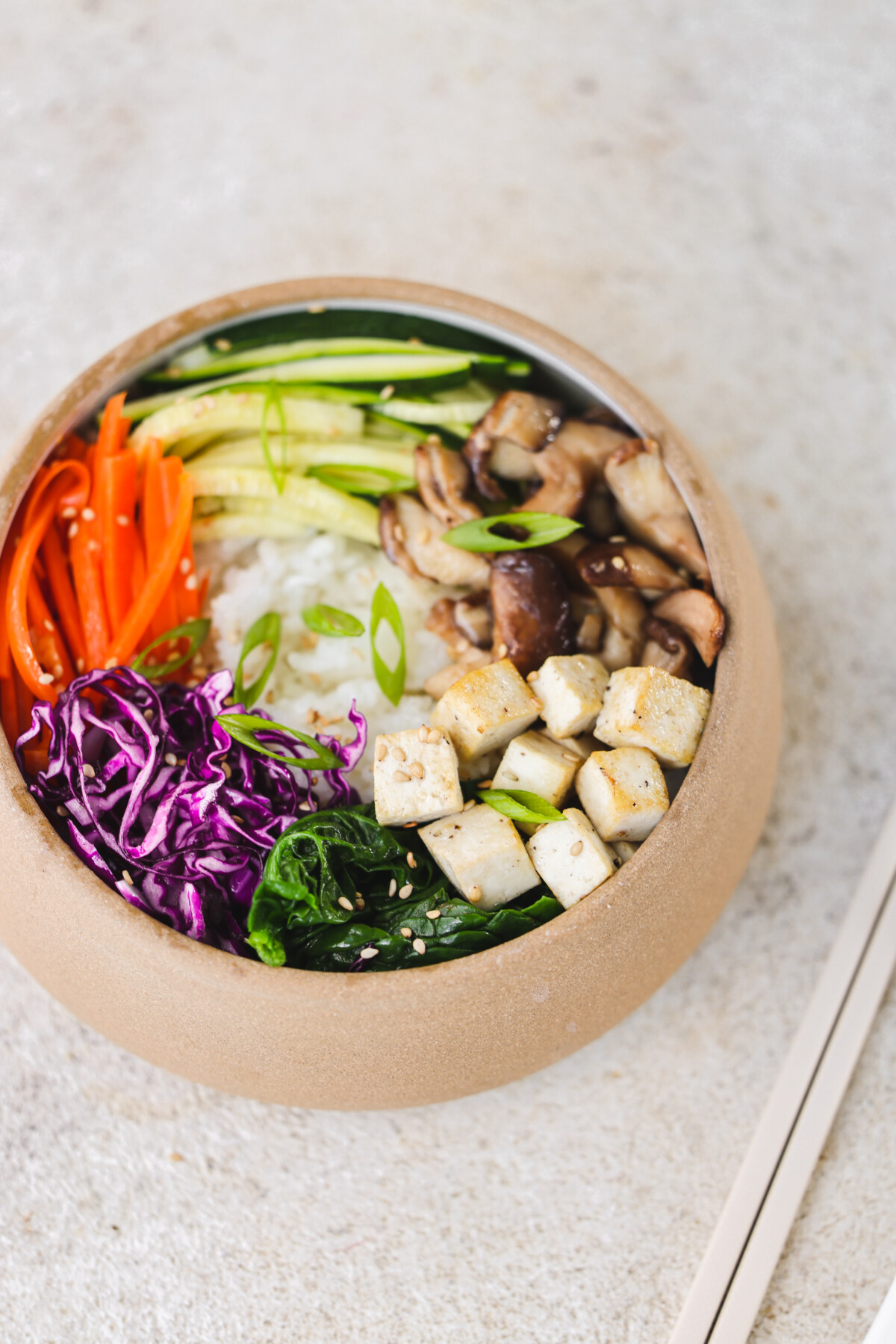
What is Bibimbap?
Korean Bibimbap (비빔밥) translates to “mixed rice” in Korean. It’s a hearty dish made up of a base of fluffy white rice, and a variety of fresh vegetables and often topped with beef, and a fried egg. The rice bowl is served with a spicy gochujang bibimbap sauce so you can add it to your liking and mix it into the rice.
You’ll often find this dish on the menu at a Korean restaurant, including Korean Barbecue restaurants. It’s such a popular Korean food, and for good reason!
What Makes This Recipe Great
I personally love this dish because it’s easy to order Vegan Bibimbap by removing any meat and/or egg and substituting it with tofu cubes. Vegan bibimbap and bibimbap sauce are both incredibly easy to make at home and are great for a quick and nutritious meal.
The ingredients used to make bibimbap tend to vary as there are a few different variations of the dish. Region and season will also impact the ingredients used and I’ve also found that each family’s bibimbap recipe varies too!
It’s an easily customizable recipe so it all comes down to personal preference and what you have available. Together with a delicious Korean bibimbap sauce, this vegan bibimbap rice bowl is absolute perfection!
Ingredient Notes
Most standard bibimbap recipes will include a base of steamed, short-grain white rice and a variety of common vegetables. Some of the vegetables are blanched and seasoned, and others are sautéed or quickly pickled. Common additions also include radish, burdock root, fiddlehead fern, and bellflower root.
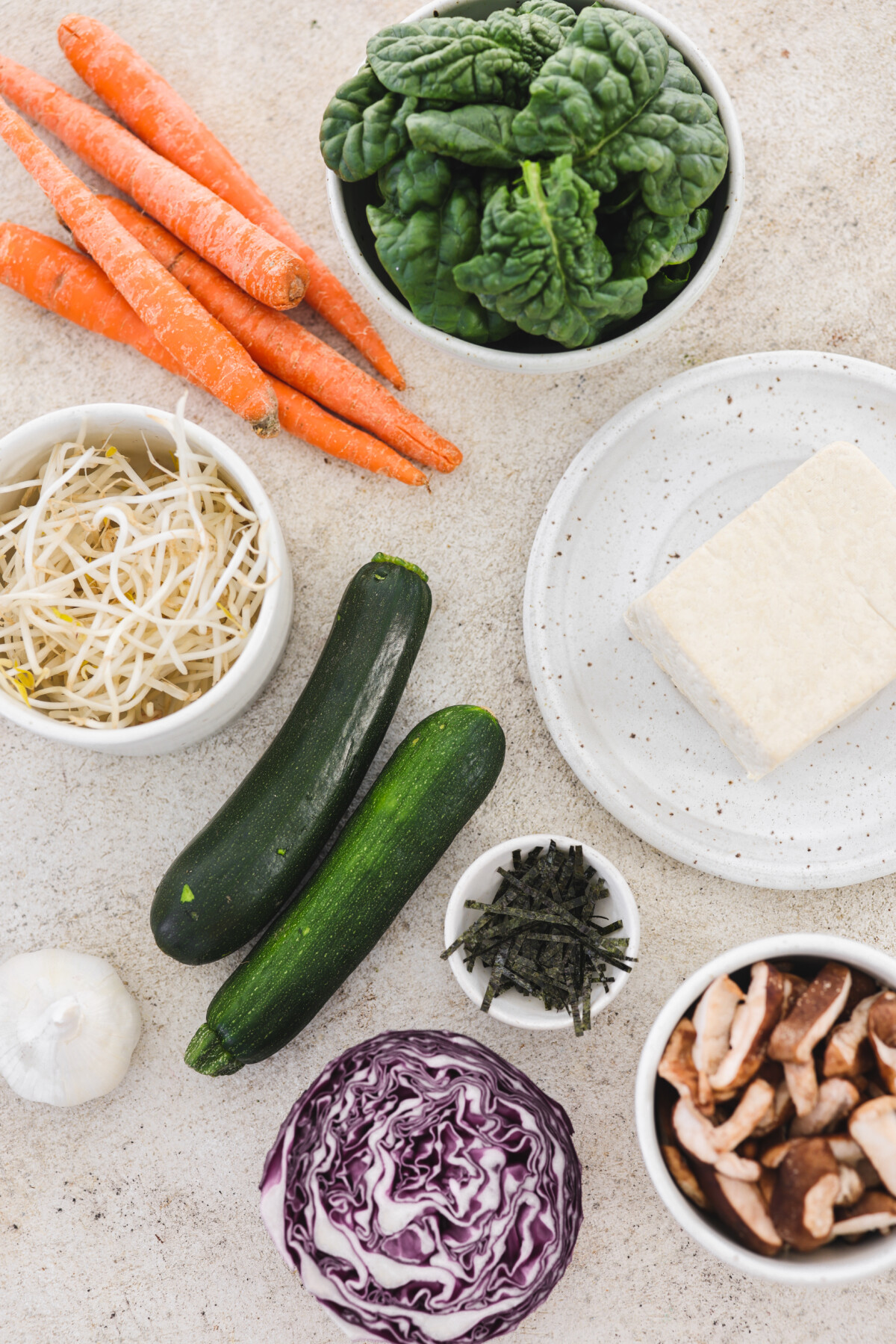
Vegan Bibimbap
- Carrot: Adds nice color and some crunch to the dish.
- Zucchini: One of my personal favourite vegetables, it gets lightly sautéed and seasoned.
- Soybean Sprouts: You can also use mung bean sprouts but soybean sprouts have extra crunch and are most commonly used in Korean cooking.
- Spinach: Blanched and seasoned.
- Mushrooms: Shiitake mushrooms are great for this vegan bibimbap bowl!
Bibimbap Sauce
Bibimbap sauce requires a few simple ingredients whisked together and adjusted to taste. It’s that easy!
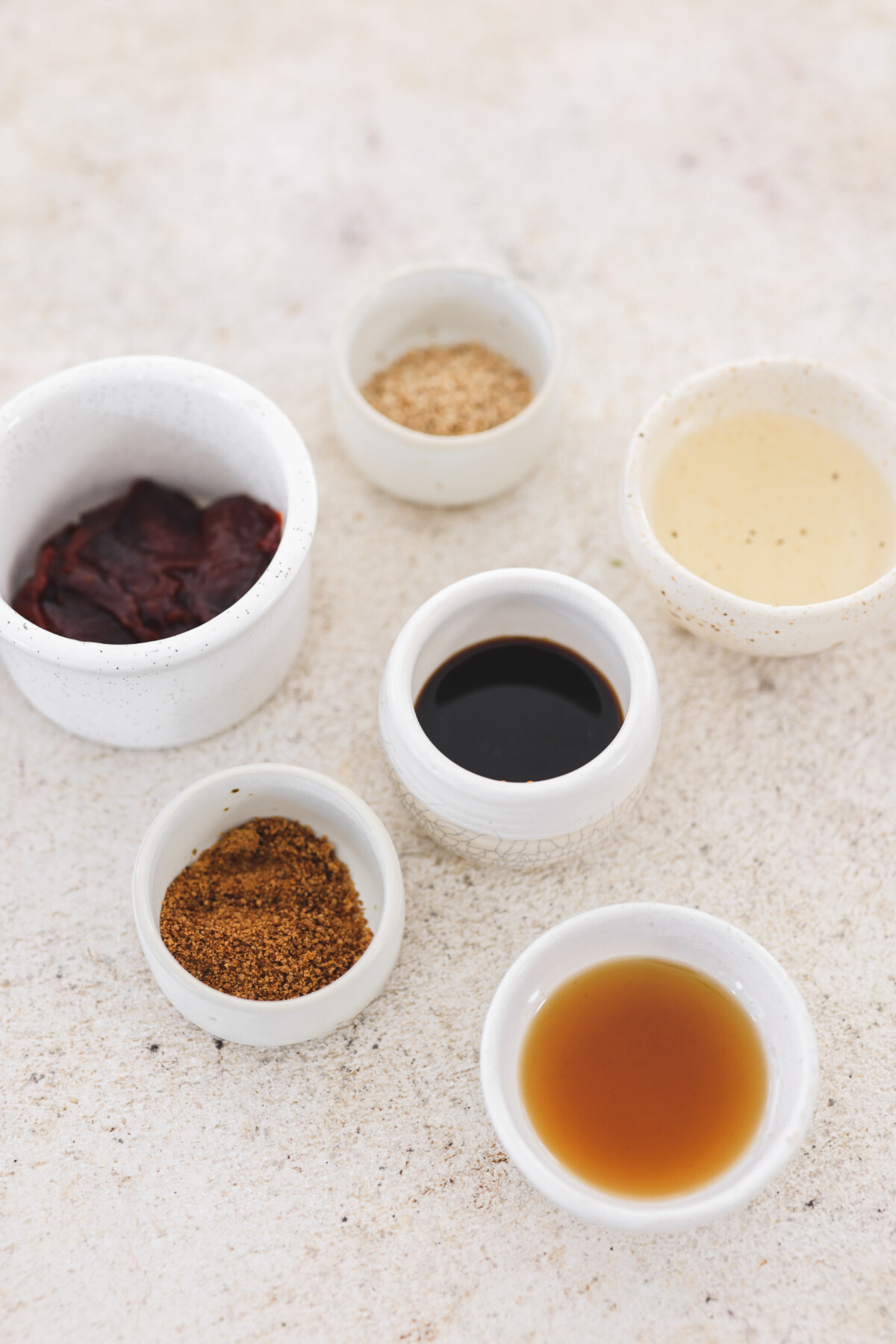
- Gochujang paste: If you want, try my amazing homemade, gluten-free gochujang recipe!
- Toasted sesame oil
- Rice Vinegar
- Tamari: This is a gluten-free soy sauce substitute.
- Sweetener: I use coconut sugar.
- Garlic: Freshly minced garlic or a jar of minced garlic will work.
How to Make Bibimbap Sauce
- Perhaps the easiest part of bibimbap sauce is just whisking together all of your ingredients together in one bowl.
- Adjust to taste, especially if you’re not a fan of spice, and set aside.
- The gochujang, or Korean red pepper paste, has such a complex flavor and is the base for many spicy Korean dishes like Bibim Guksu, spicy cold noodles. It is what contributes to a lot of the spice, so feel free to use less if you find it to be quite spicy.
- You can also try my homemade gochujang sauce which allows you to customize the flavors even more.
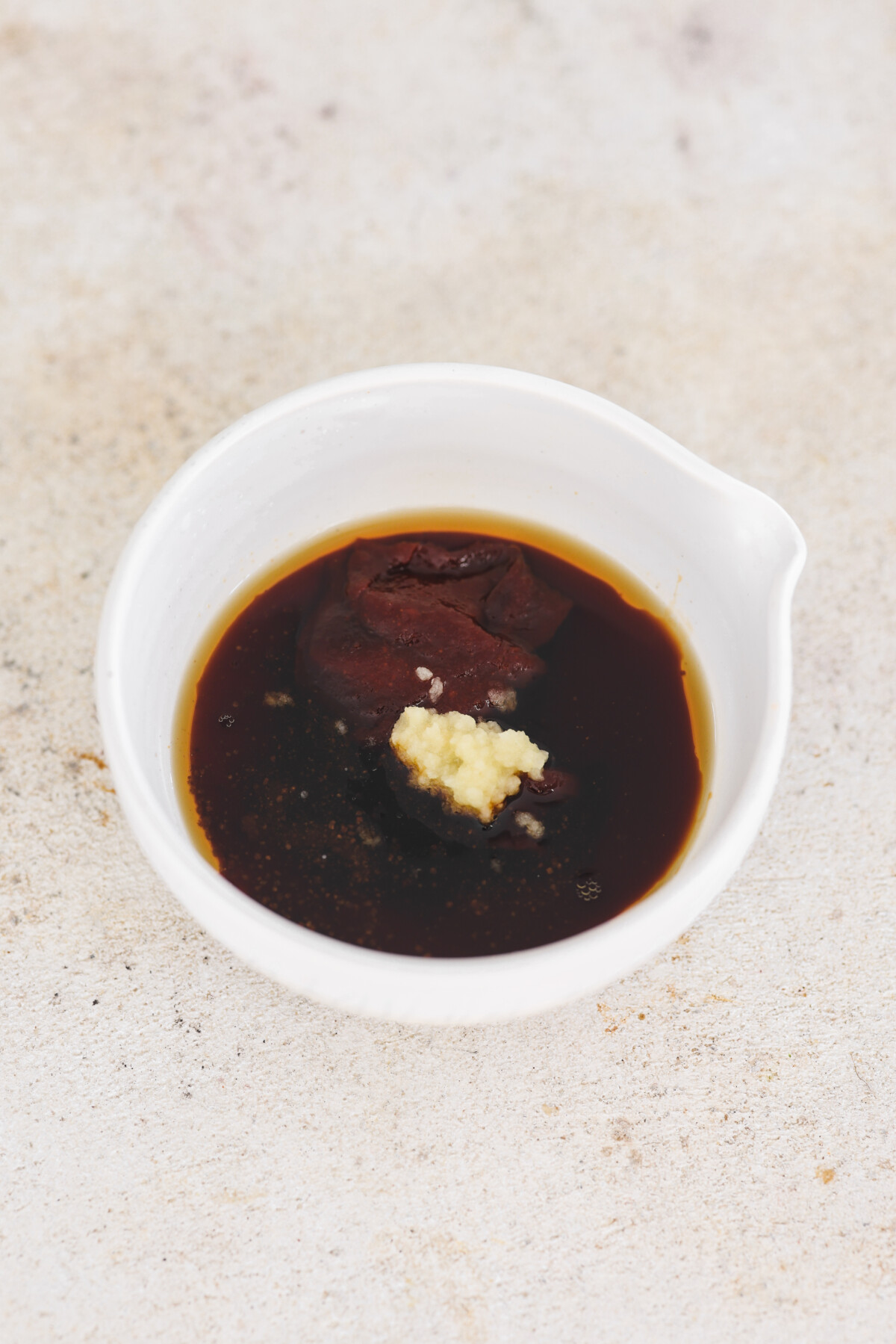
How to Make Vegan Bibimbap
This vegan bibimbap recipe is incredibly easy to make and tastes as if it came from a restaurant. Traditionally, all of the ingredients are individually prepared and then combined to create the final dish.
Step-by-Step Instructions
Cooking the Rice
The rice should be cooked so that it’s fluffy, delicious, and not too gummy. Korean dishes are served with short-grain rice and it is best made in a rice cooker versus a stovetop.
- To start, you’ll want to cook white rice. I like to use a Zojirushi rice cooker because it allows a hands-off cooking experience and gives me time to prepare other elements of the dish while it cooks.
- Be sure to wash your rice before cooking. This not only helps remove any debris and dirt but also excess starch. I recommend rinsing in cold water and draining off excess water 3-4 times until the water runs fairly clear.
- Always use the rice measuring cup and water lines to make sure you’re cooking the rice precisely. Zojirushi’s rice cookers come with a rice measuring cup and have clear marks on the inside of the cooking pot to indicate how much water should be added for each variety of rice.
- Finally, make sure you’re using the correct rice cooker setting! The Micom Rice Cooker has various settings, and you’ll want to use the Quick setting or the regular White setting to make perfect short-grain rice.
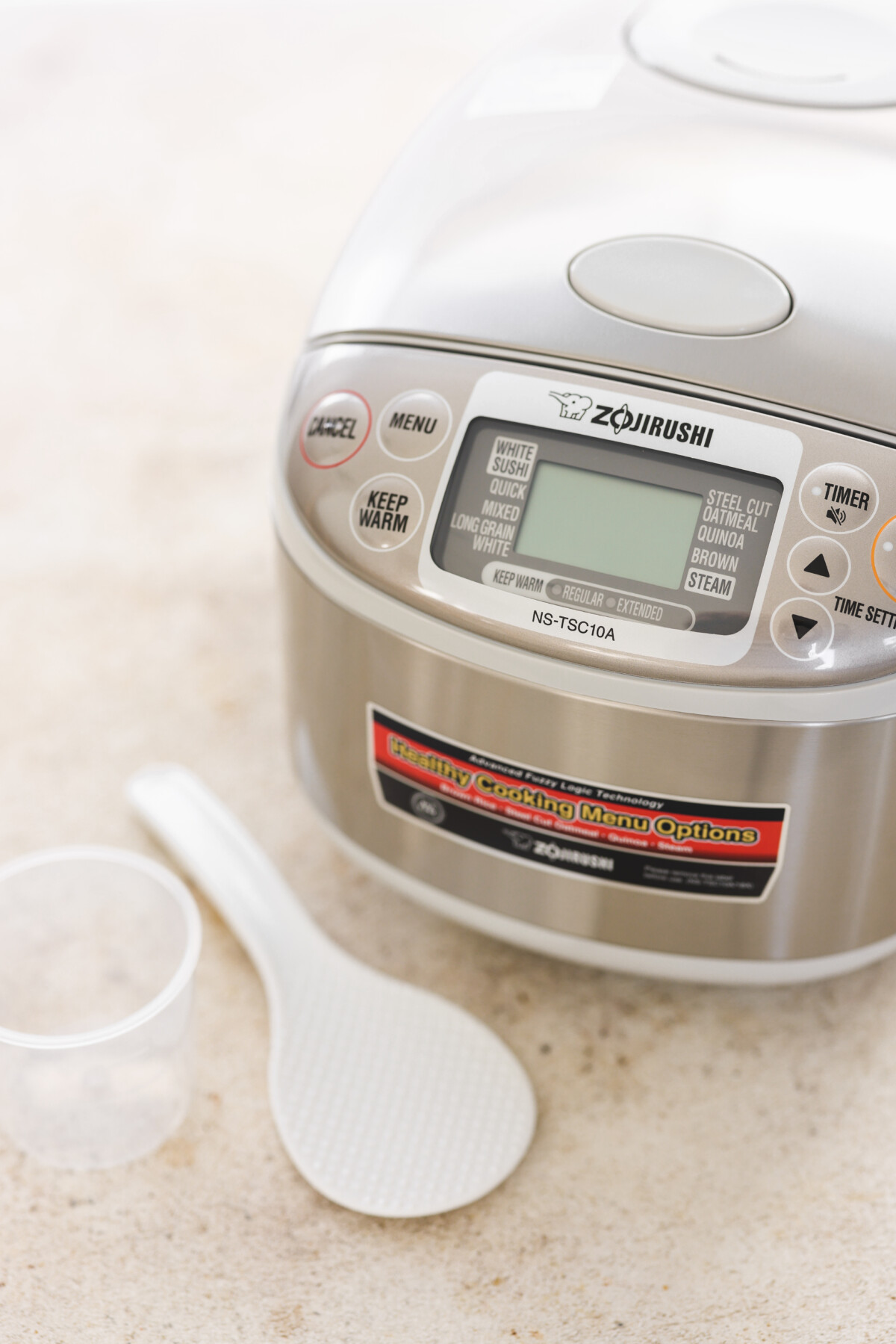
Preparing the Vegetables and Tofu
- While the rice is cooking, you can blanch and sauté your vegetables. The spinach and soybean sprouts will both be blanched and seasoned.
- To blanch, bring a pot of water to a boil, toss the vegetables in for a few seconds until slightly wilted, then remove and shock in a bowl of ice water to stop the cooking process.
- Using your hands, squeeze out as much water as possible and then season.
- The carrots, zucchini, and mushrooms will each be sautéed on a large skillet over medium heat with neutral oil and an optional touch of sesame oil, garlic, salt, and pepper.
- For the pickled element, I love to use cabbage and I’ll create a “quick pickle” by seasoning it with rice wine vinegar, freshly grated garlic, salt, and pepper. You can also add in a little sesame oil if you’d like. Alternatively, the carrots could also serve as your pickled element!
- I like to quickly pan-fry extra firm or high-protein tofu over medium-high heat. These varieties are firmer in texture which makes for a great topping and I simply season with salt and pepper because the bibimbap sauce adds so much flavor. If you like crispy tofu, make sure to cook it until it’s golden brown.
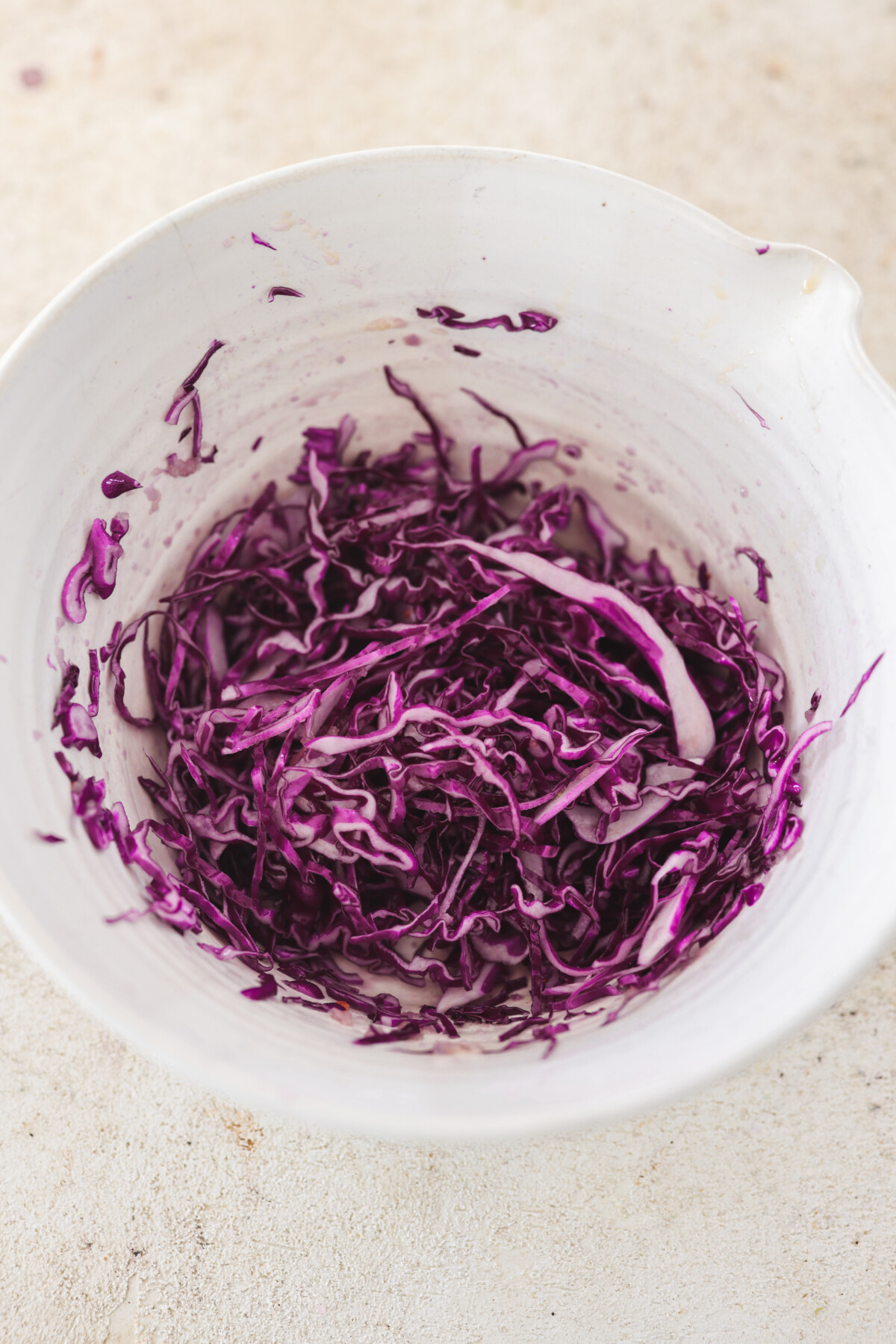
Serve and Enjoy!
- To assemble, start with a base of cooked rice, then arrange each of the seasoned elements around the perimeter of the bowl.
- Top with any garnish desired like shredded seaweed, toasted sesame seeds, scallions/green onions, and as much bibimbap sauce as you’d like, then mix it up and enjoy.
Expert Tips
- How to Make it Gluten-Free: The only substitutions you’ll need to make gluten-free bibimbap include soy sauce, which I would recommend replacing with tamari or coconut aminos and possibly the gochujang. There are several gluten-free gochujang pastes available so just do a quick scan of the ingredients to check that it is gluten-free.
- Sourcing Ingredients: Most bibimbap ingredients are commonly found at any grocery store and I focused on including more of the common vegetables as toppings to make it even simpler.
- If you have trouble finding shiitake mushrooms, gochujang, rice wine vinegar, or seaweed, I recommend checking your local Asian market or Korean grocery store if you have one accessible to you.
- Otherwise, you can also find these ingredients online. Tip: Trader Joe’s recently started selling gochujang if there’s one near you!
- Short-grain rice is sometimes labeled “sushi rice” or “sticky rice” at conventional grocery stores. If you prefer brown rice, it will work as a substitute.
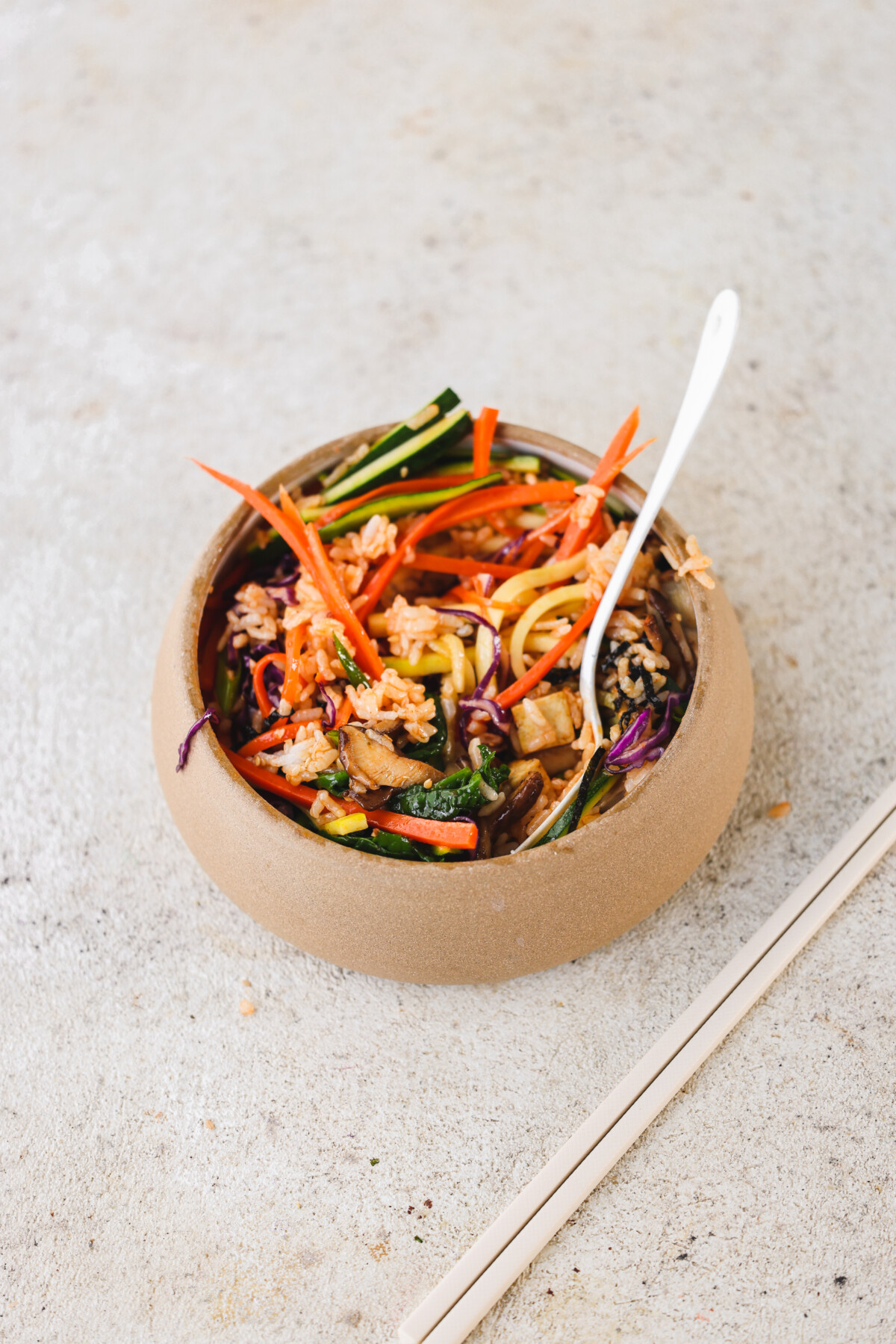
Substitutions
- I encourage making ingredient substitutions where you need to, especially with regard to the vegetables.
- Making my homemade gochujang will help you adjust the spice level of your bibimbap sauce.
- This vegan bibimbap can be a great fridge cleanout meal to make with leftover vegetables and you can even swap out rice for another cooked grain or carb like quinoa, buckwheat, millet, and more!
Meal Prep & Storage Tips
- Vegan bibimbap is a great recipe for meal prep! I often make rice in larger batches and store leftovers in the fridge to eat throughout the week.
- If you’d like to meal prep, simply make enough rice for each meal and multiply the recipe to make enough sauce and vegetables for each meal.
- You can store each of the vegetable elements separately or in a large airtight container and keep it in the fridge.
- I recommend adding the bibimbap sauce just before you enjoy it and storing that separately in the fridge as well.
- Store leftovers in the refrigerator for up to 3-4 days. Reheat before enjoying.
Serving Tips
- I like to top my vegan bibimbap with fresh green scallions, toasted white sesame seeds, seaweed, and sometimes kimchi or pickled yellow radish.
- I recommend adding scallions and seaweed just before consuming. To save time, don’t feel bad about mixing it all together and serving it like fried rice!
- If you’re entertaining or making this recipe for a family, consider serving all of the elements in separate bowls and creating a bibimbap bar so that everyone can customize their rice bowl. Make sure to have plenty of bibimbap sauce!
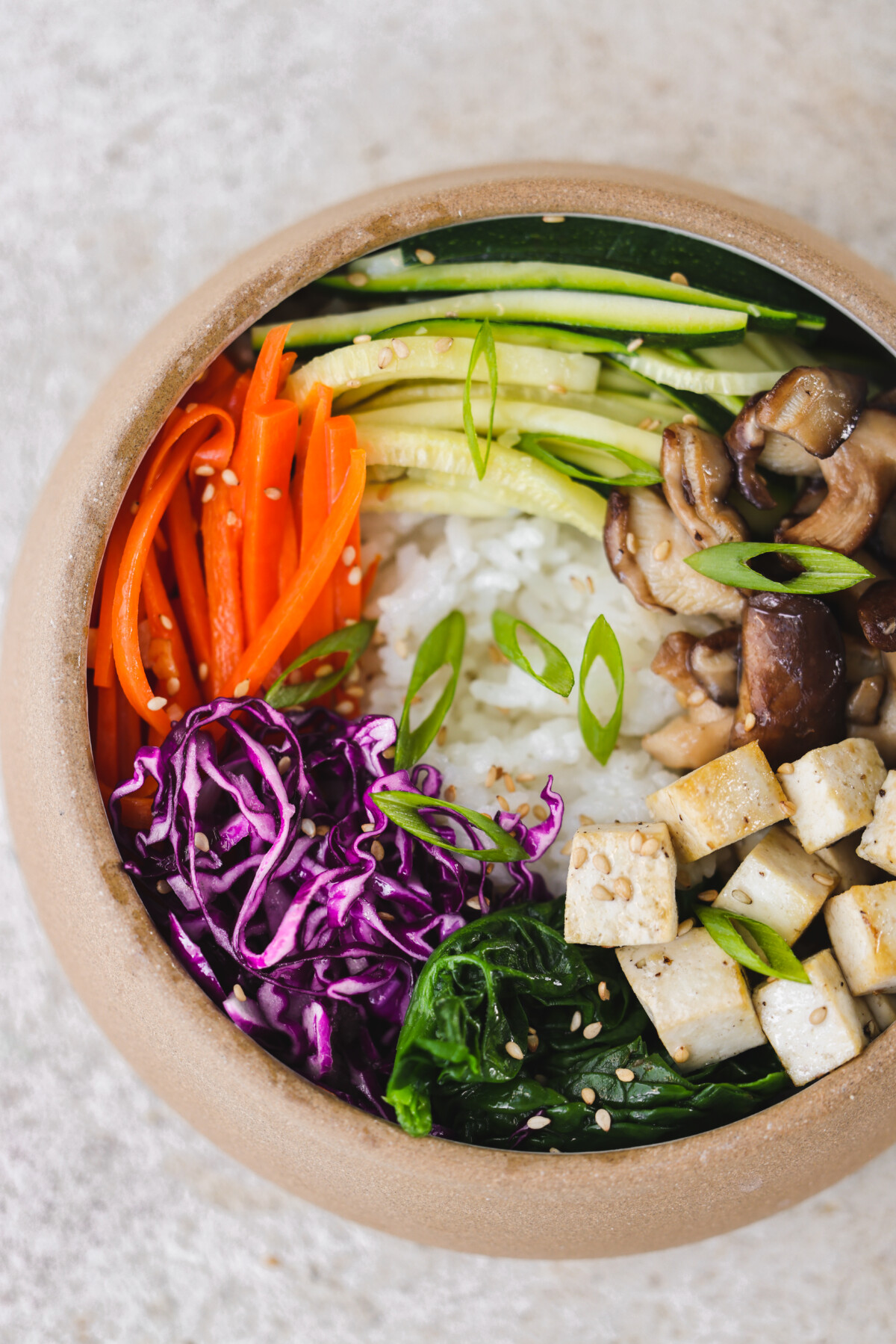
Variations
- If you like this vegan bibimbap recipe, you might also like a few of the other varieties like Jeonju Bibimbap, which originated in Western South Korea.
- Yeolmu Kimchi Bibimbap which is a great one for any kimchi lovers out there or Jinju Bibimbap which features raw meat.
- There are also seafood and fish-based varieties like Andong Bibimbap served with a sauce that omits the spice.
- Hoedeobap is my mum’s favorite variety, has raw fish, and can be served as a salad instead of a rice bowl.
- My dad’s favorite is the wild vegetable variety, also called Sanchae Bibimbap. This one is less commonly seen on restaurant menus but is a treat if you ever come across it.
- Dolsot Bibimbap is the most popular variety. It is served in a sizzling hot stone pot. The heat from the stone pot grills the bottom of the rice dish and at the end of the meal, you end up with crispy bits of rice-perhaps the best part of the meal!
More Vegan Asian Recipes to Try!
Korean Sweet Cinnamon Pancakes | Hotteok
If you try this vegan bibimbap with homemade bibimbap sauce recipe, tag me on Instagram @veggiekins so I can see your delicious re-creations and for a chance to be featured! As always, I love when you share your reviews in the comments below, and if you make any fun substitutions, let me know how it worked out below too!
Vegan Bibimbap 비빔밥 | Korean Mixed Rice (with Bibimbap Sauce Recipe)
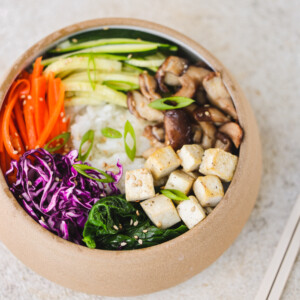
Equipment
- rice cooker
- frying pan
- serving bowls
Ingredients
- 2 servings cooked short grain white rice I usually use about a cup of cooked rice per serving
Vegetables
- 2-3 cups spinach
- 2 carrots peeled and julienned
- 2 cups cabbage finely shredded
- 1 zucchini large, julienned
- 1-2 cups soybean sprouts
- 1 1/2 cup shiitake mushrooms sliced
- 6 oz high protein tofu cubed
- 4 cloves garlic minced
- salt and pepper to taste
- 4.5 tsp toasted sesame oil
- 1 clove garlic grated or finely minced
- 1/4 tsp coconut sugar or sugar of choice
- 2 tsp rice wine vinegar
Bibimbap Sauce
- 1/4 cup gochujang
- 1 tbsp toasted sesame oil
- 1/2 tsp coconut sugar optional
- 1-2 tsp tamari to taste
- 2 tsp rice wine vinegar
- 1 clove garlic finely grated
- water as needed, to thin
Garnish
- toasted white sesame seeds
- sliced green onion
- shredded roasted seaweed
- kimchi
Instructions
Vegan Bibimbap Recipe
Spinach
- Bring a small pot of water to a boil and quickly blanch the spinach by submerging in water for about 30 seconds to a minute. Immediately remove the spinach from the pot and shock by placing in a bowl of cold water, or rinsing under cool water.
- Use your hands to squeeze out any excess water, then toss spinach with seasoning ingredients, to taste.
Zucchini
- Heat a little neutral oil in a pan over medium heat and add zucchini. Sauté for 2-3 minutes until lightly golden on the edges then add garlic and cook for another minute. Season with salt, to taste.
Carrots
- Heat a little neutral oil in a pan over medium heat and add carrots. Sauté for 2-3 minutes until vibrant in colour and slightly tender then season with salt and pepper, to taste.
Cabbage
- Add shaved cabbage to a mixing bowl along with all seasoning ingredients and toss using tongs or your hands, to coat. Make sure seasoning covers all of the cabbage and then let sit. Drain off any excess liquid at the bottom of the bowl.
Soybean Sprouts
- Bring a small pot of water to a boil and quickly blanch the soybean sprouts by submerging in water for about a minute or two. Immediately remove the soybeans sprouts from the pot and shock by placing in a bowl of cold water, or rinsing under cool water.
- Toss blanched soybean sprouts with seasoning ingredients, to taste.
Tofu
- Heat a little neutral oil in a pan over medium heat and add tofu. Sauté for 3-5 minutes until lightly golden brown and then season with salt and pepper, to taste.
Mushrooms
- Heat a little neutral oil in a pan over medium heat and add mushrooms. Sauté for 3-5 minutes until tender and slightly shrunken, then add toasted sesame oil and salt and pepper, to taste.
Making the Rice
- Be sure to wash your rice before cooking. This not only helps remove any debris and dirt but also excess starch. I recommend rinsing in cool water and draining off excess water 3-4 times until the water runs fairly clear.
- Always use the rice measuring cup and water lines to make sure you’re cooking the rice precisely. Zojirushi’s rice cookers come with a rice measuring cup and have clear marks on the inside of the cooking pot to indicate how much water should be added for each variety of rice.
- Finally, make sure you’re using the correct rice cooker setting! The Micom Rice Cooker has various settings and you’ll want to use the Quick setting or the regular White setting to make perfect short-grain rice.
Bibimbap Sauce
- Whisk together all sauce ingredients, adjusting to taste. You can start with half of the gochujang and add more as you go if you're sensitive to spice.
Assembling the Vegan Bibimbap
- Start with a base of rice in a bowl for each serving (if using a dolsot, make sure the dolsot is preheated and ripping hot). Arrange each of the ingredients around the perimeter of the bowl in little piles then garnish with desired topping of choice. Serve with sauce on the side, and add to taste.
Notes
Expert Tips
-
- How to Make it Gluten-Free: The only substitutions you’ll need to make gluten-free and vegan bibimbap include soy sauce, which I would recommend replacing with tamari or coconut aminos and possibly the gochujang. There are several gluten-free gochujang pastes available so just do a quick scan of the ingredients to check that it is gluten-free.
-
- Where to Find the Ingredients: Most vegan bibimbap ingredients are commonly found at any grocery store and I opted to focus on including more of the common vegetables as toppings to make it even simpler.
-
- If you have trouble finding shiitake mushrooms, gochujang, rice wine vinegar, or seaweed, I recommend checking your local Asian market or Korean grocery store if you have one accessible to you.
-
- Otherwise, you can also find these ingredients online. Tip: Trader Joe’s recently started selling gochujang if there’s one near you!
-
- If you’re looking for short-grain rice, it is sometimes labeled “sushi rice” or “sticky rice” at conventional grocery stores.
-
- Where to Find the Ingredients: Most vegan bibimbap ingredients are commonly found at any grocery store and I opted to focus on including more of the common vegetables as toppings to make it even simpler.
Substitutions
-
- I encourage making ingredient substitutions where you need to, especially with regard to the vegetables.
-
- This vegan bibimbap can be a great fridge cleanout meal to make with leftover vegetables and you can even swap out rice for another cooked grain or carb like quinoa, buckwheat, millet, and more!
Meal Prep & Storage Tips
-
- Vegan bibimbap is a great recipe for meal prep! I often make rice in larger batches and store leftovers in the fridge to eat throughout the week.
-
- If you’d like to meal prep, simply make enough rice for each meal and multiply the recipe to make enough sauce and vegetables for each meal.
-
- You can store each of the vegetable elements separately or in a large airtight container and keep it in the fridge.
-
- I recommend adding the bibimbap sauce just before you enjoy it and storing that separately in the fridge as well.
-
- Leftovers should last 3-4 days in the refrigerator and should be reheated before enjoying.
Serving Tips
-
- I like to top my vegan bibimbap with fresh green scallions, toasted white sesame seeds, seaweed, and sometimes kimchi or pickled yellow radish.
-
- I recommend adding scallions and seaweed just before consuming and although arranging the toppings on the rice is traditionally how it is served if you’d like to save time, don’t feel bad about mixing it all together and serving it like fried rice!
-
- If you’re entertaining or making this recipe for a family, consider serving all of the elements in separate bowls and creating a bibimbap bar so that everyone can customize their rice bowl. Make sure to have plenty of bibimbap sauce!
Nutrition information is automatically calculated, so should only be used as an approximation.
*The sweepstakes has officially ended–congraulations to Anne!


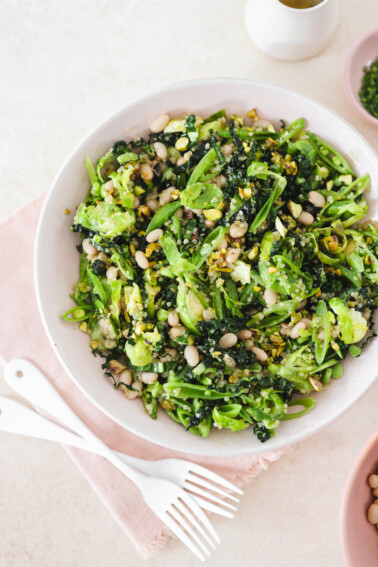
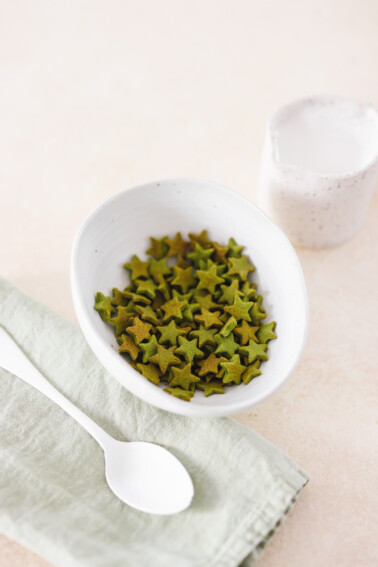
157 Comments